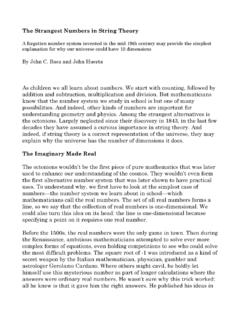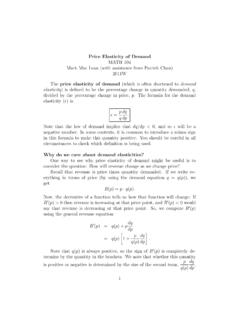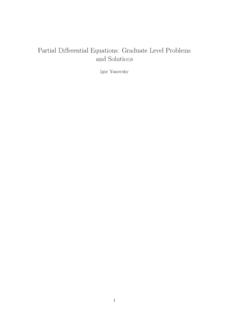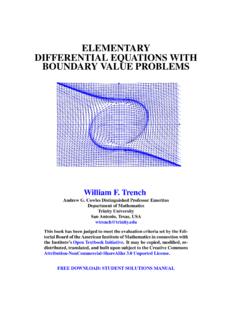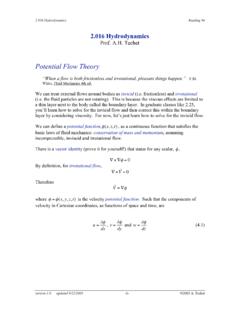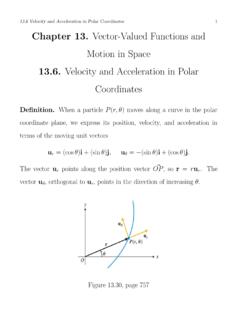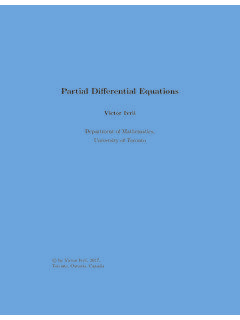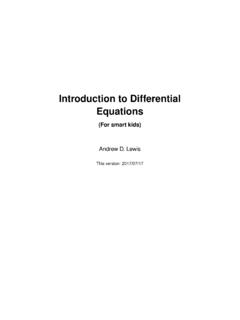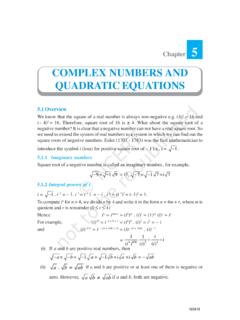Transcription of Introducing The Quaternions - Department of Mathematics
1 Introducing The QuaternionsIntroducing The QuaternionsJohn HuertaDepartment of MathematicsUC RiversideFullerton CollegeIntroducing The QuaternionsThe Complex NumbersIThe complex numbersCform a operations are very related to particular, multiplication by a unit complex number:|z|2=1which can all be written:z=ei gives arotation:Rz(w) =zwby angle . Introducing The QuaternionsThe Complex NumbersHow does this work?IC={a+bi:a,b R,i2= 1}IAny complex number has a length, given by thePythagorean formula:|a+bi|= a2+ can add and subtract inC. For example:a+bi+c+di= (a+c) + (b+d) can also multiply, which is much messier:(a+bi)(c+di) = (ac bd) + (ad+bc)iWhat does this last formula mean? Introducing The QuaternionsThe Complex NumbersFortunately, there is a better way to multiply complex numbers,thanks to Leonhard Euler:Figure: Handman s portrait of proved:ei =cos +isin Introducing The QuaternionsThe Complex NumbersGeometrically, this formula saysei lies on the unit circle inC:Figure: Euler s The QuaternionsThe Complex NumbersIei has unit we multiply by a positive number,r, we get a complexnumber of lengthr:rei.
2 IBy adjusting the lengthrand angle , we can write anycomplex number in this way!IIn a calculus class, this trick goes by the The QuaternionsThe Complex NumbersAnd this gives a great way to multiply complex numbers:IRemember our formula was:(a+bi)(c+di) = (ac bd) + (ad+bc)iIInstead, we can write each factor in polar coordinates:a+bi=rei ,c+di=sei IAnd now:(a+bi)(c+di) =rei sei =rsei( + ).IIn words: to multiply two complex numbers,multiply theirlengths and add their angles! Introducing The QuaternionsThe Complex NumbersIn particular, if we multiply a given complex numberzbyei which has unit length 1, the result:ei zhas the same length is rotated by The QuaternionsHamilton s DiscoverySo, we can usecomplex arithmetic(multiplication) to do ageometric operation(rotation).The 19th century Irish mathematician and physicist WilliamRowan Hamilton was fascinated by the role ofCintwo-dimensional The QuaternionsHamilton s DiscoveryFor years, he tried to invent an algebra of triplets to play thesame role in three dimenions:a+bi+cj , we now know this quest was in only normed division algebras, which are number systemswhere we can add, subtract, multiply and divide, and whichhave a norm satisfying|zw|=|z||w|have dimension 1, 2, 4, or The QuaternionsHamilton s DiscoveryHamilton s search continued into October, 1843:Every morning in the early part of the above-cited month, onmy coming down to breakfast, your (then) little brother WilliamEdwin, and yourself, used to ask me: Well, Papa, can youmultiply triplets?
3 Whereto I was always obliged to reply, with asad shake of the head: No, I can only add and subtract them. Introducing The QuaternionsHamilton s DiscoveryOn October 16th, 1843, while walking with his wife to a meetingof the Royal Society of Dublin, Hamilton discovered a4-dimensional division algebra called thequaternions:That is to say, I then and there felt the galvanic circuit of thoughtclose; and the sparks which fell from it were the fundamentalequations between i, j, k; exactly such as I have used them eversince:i2=j2=k2=ijk= The QuaternionsHamilton s DiscoveryHamilton carved these equations onto Brougham Bridge. Aplaque commemorates this vandalism today:Figure: Brougham Bridge by Tevian The QuaternionsThe QuaternionsThe Quaternions areH={a+bi+cj+dk:a,b,c,d R}.Ii,jandkare all square roots of ji,jk=i= kj,ki=j= we shall see, we can use Quaternions to do rotations that these relations (ij=k= ji, etc) all follow fromHamilton s definition:i2=j2=k2=ijk= The QuaternionsThe QuaternionsIThe Quaternions don t commute!
4 IA useful mnemonic for multiplication is this picture:Figure: Multiplying by John The QuaternionsThe QuaternionsIIf you have studied vectors, you may also recognizei,jandkas unit quaternion product is the same as thecross productof vectors:i j=k,j k=i,k i= , for the cross product:i i=j j=k k=0while for Quaternions , this is fact, we can think of a quaternion as having a scalar(number) part and a vector part:v0+v1i+v2j+v3k= (v0,v). Introducing The QuaternionsThe QuaternionsWe can use the cross product, and thedot product:v w=v1w1+v2w2+v3w3to define the product of Quaternions in yet another way:(v0,v)(w0,w) = (v0w0 v w,v0w+w0v+v w).PuzzleCheck that this formula gives the same result for quaternionmultiplication as the explicit rules for multiplyingi,j, The QuaternionsRotations Using QuaternionsI promised we could use Quaternions to do 3d rotations, sohere s how:IThink of three-dimensional space as being purelyimaginary Quaternions :R3={xi+yj+zk:x,y,z R}.
5 IJust like for complex numbers, the rotations are done usingunit Quaternions , like:cos +isin ,cos +jsin ,cos +ksin .IBy analogy with Euler s formula, we will write these as:ei ,ej ek . Introducing The QuaternionsRotations Using QuaternionsBut there are many more unit Quaternions than these!Ii,j, andkare just three special unit imaginary any unit imaginary quaternion,u=u1i+u2j+ is, anyunit +usin is a unit analogy with Euler s formula, we write this as:eu . Introducing The QuaternionsRotations Using QuaternionsTheoremIfuis a unit vector, andvis any vector, the expressioneu ve u ,gives the result of rotatingvabout the axis in The QuaternionsRotations Using will prove this foru=i, since there is nothing special (v1i+v2j+v3k)e i =ei (v1i+ (v2+v3i)j)e i Puzzle!=ei (v1i)e i +ei (v2+v3i)je i =ei (v1i)e i +ei (v2+v3i)e+i jPuzzle!
6 =v1i+ei2 (v2+v3i)jPuzzle!Note the 2 ! Introducing The QuaternionsRotations Using QuaternionsTheorem (Improved)Ifuis a unit vector, andvis any vector, the expressioneu ve u ,gives the result of rotatingvabout the axis in theudirection by2 , this 2 is important when describing electrons! Introducing The QuaternionsRotating an ElectronLet s write the rotation we get from the unit quaternioneu as:Reu (v) =eu ve u This is a rotation by 2 . To rotate by , we need:Reu /2(v) =eu /2ve u /2 And to say how this relates to electrons, we need to talk aboutquantum The QuaternionsRotating an ElectronQuantum mechanics says that particles are represented bywaves:IThe simplest kind of wave is a function: :R RIBut since we live in three dimensions: :R3 RIAnd because it s quantum, it s complex-valued: :R3 CIYet, in 1924, Wolfgang Pauli (secretly) discovered that forelectrons, it squaternion-valued: :R3 HIntroducing The QuaternionsRotating an ElectronIf we rotate most particles, we rotate its wave:Reu /2 (v) := (Re u /2(v)).
7 But to rotate an electron, Pauli found:Reu /2 (v) :=eu /2 (Re u /2(v)).In particular, for a =360 rotation:Reu360 /2 (v) =eu180 (v) = (v).Electrons can tell if they have been rotated 360 degrees!

